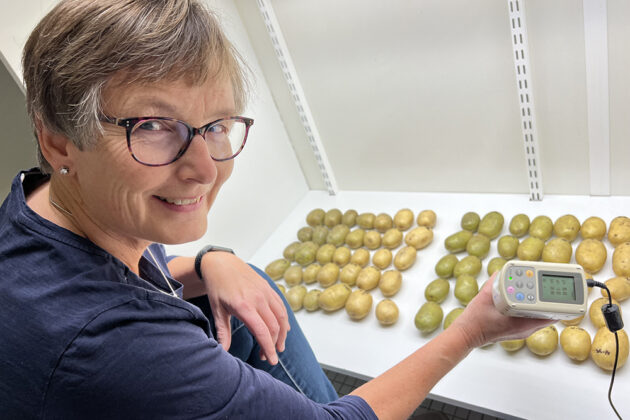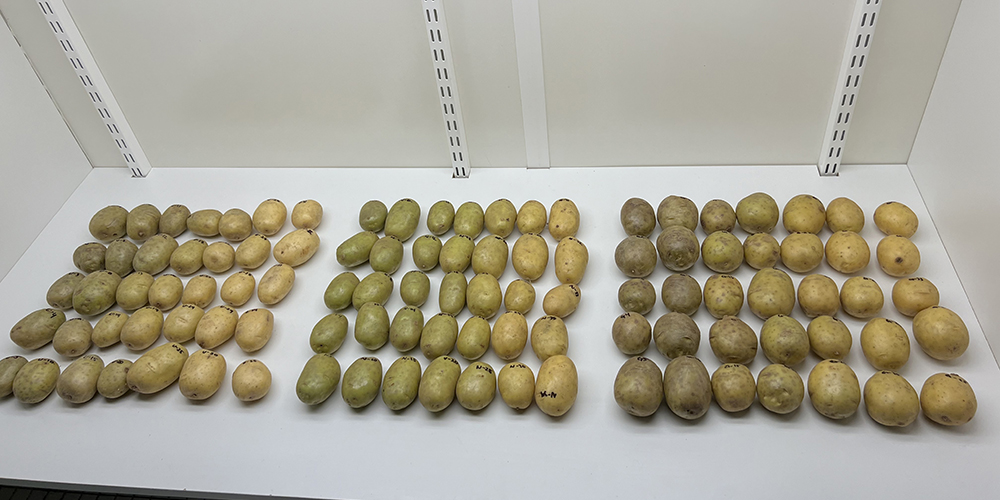Greening of Potatoes in Stores Leads to Food Waste

Researchers have investigated how light and temperature affect the greening of potatoes. Cool storage can significantly slow down the greening process, but current packaging solutions do not provide adequate protection against light.
“Potatoes stored at room temperature turn green much faster than at 4-6°C, but there are significant variations between different potato varieties,” says senior scientist Hanne Larsen at Nofima.
Cool Storage is an Effective Measure
Greening of potatoes is a major problem that leads to food waste throughout the value chain from farmer to consumer.
“Cool storage in stores would be an effective measure to reduce greening. Refrigerated counters set to 4-6°C could work well for potatoes,” says Hanne Larsen.
The researchers have conducted several tests, and there are significant differences between different potato varieties. They chose to take a closer look at the Folva variety. This is a variety with a large volume, and its light skin often poses challenges with greening in stores. At higher temperatures, already at 8°C, they found that Folva potatoes were greener after 14 days in light at this temperature than at 4 and 6°C.
No Packaging Solutions Met the Standard
The lower the light transmission, the better. The researchers examined seven different packaging materials. Two of these were plastic, the rest were paper. Among the paper variants, two had black print on the inside. The Folva variety was also chosen for these tests.
“In short, light transmission was highest for beige-coloured plastic and lowest for paper bags with black print on the inside, but none of the tested packaging variants provided sufficient protection against light. The packaged potatoes turned green after 2 days at 20°C and 9 days at 6°C. These findings are useful when choosing packaging material,” points out Hanne Larsen.
Investigated Seven Different Potato Varieties
Hanne Larsen, together with Eldrid Lein Molteberg from NIBIO, has investigated how various factors affect greening and the formation of glycoalkaloids in different potato varieties.
The seven varieties the researchers looked at were potato varieties suitable for cultivation in Norway. There were three red varieties: Asterix, Nansen, Rutt. The relevant yellow varieties were Celandine, Folva, Hassel, and Mandel.
“Celandine tolerates light the best; it takes 60 hours before these potatoes become unacceptably green when stored at 20°C. Nansen, which is the most resistant among the red varieties, becomes unacceptably green after 48 hours at 20°C. Mandel potatoes are at the other end of the scale. It takes only one day before they become unacceptably discoloured,” says Hanne Larsen.
Potatoes exposed to light develop toxic glycoalkaloids in addition to greening. The limit for glycoalkaloid content in fresh potatoes is set at a maximum of 200 mg/kg fresh weight, and large amounts of potatoes must be consumed to show symptoms of poisoning.
Overview of the Seven Potato Varieties
| Red varieties | Yellow varieties | ||||||
|---|---|---|---|---|---|---|---|
| Asterix | Nansen | Rutt | Celandine | Folva | Hassel | Mandel | |
| Number of hours before unacceptable colour change |
36 | 48 | 36 | 60 | 36 | 36 | 24 |
| Total amount of glycoalkaloids, mg/kg Fresh weight at the start |
179 | 93 | 136 | 149 | 199 | 137 | 193 |
| Total amount of glycoalkaloids, mg/kg Fresh weight after 36 hours |
223 | 160 | 180 | 182 | 290 | 223 | 192 |
Table: Colour change was measured after 0, 21, 24, 36, 48, 60, 72, and 84 hours under LED light at 20°C. The potatoes were visually assessed and show the number of hours in light before the potatoes were considered unacceptable.
The overview shows that the glycoalkaloid content in potatoes varies, and they react differently to light. Three potato varieties exceeded the limit after 36 hours, and all of these were considered unacceptably discoloured at the same time.
“We hope that these results can motivate stores to develop better solutions that can reduce food waste and ensure better potato quality for consumers,” concludes Hanne Larsen.

Facts about the Research:
The project was carried out in collaboration with the wholesalers Norgesgruppen and Bama. The goal was to find measures that can reduce the amount of green potatoes in stores.
The research work was carried out in the project “Green Potatoes in Stores” funded by Grofondet and Nofima’s strategic programme “FutureFoodControl” funded by the Fund for Research Levy on Agricultural Products (FFL).
